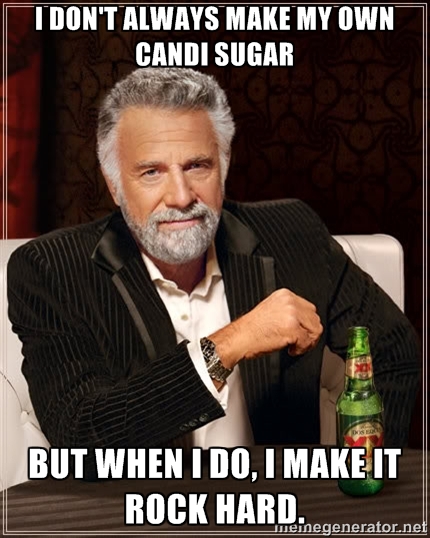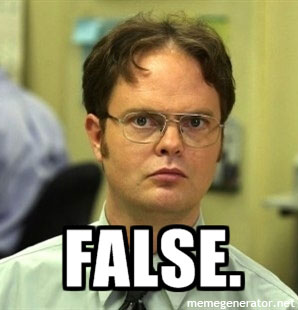Fedora
Glorified Janitor
Ramen noodle juice. Mmm

So making candi sugar isnt necessary? If the wort can invert table or beet sugar itself, there would be not point in making candi sugar. The whole process of making candi sugar is to invert it. Boiling wort would not bring the sugar/acid up to a hot enough temp to invert it (260-275*F)
I've read numerous times where people say that making candi sugar is unnecessary because the sugar will invert in the boiling wort anyway. I'm no expert on that subject, but I will offer my opinion. I personally wouldn't waste my time making clear candi sugar. I would just do what I've always done, and add corn sugar. Most likely get the same effect. What made me want to make candi sugar is the fact that I wanted dark sugar. That's the only advantage, to me, to making candi sugar, is if you want the flavor contributions that would come from amber or darker.
where are you and why am i not there?????
afternoon coffee.... the struggle is real
You ever talk to someone, a month after the wedding, who did the disposables on the table thing?
Every person I know who did that said there were more penis pictures on those things than they could count. Booze + cameras + access to public restrooms = penises all over the place. You can check my math, but I'm pretty sure it checks out.
I just use my wife's non-stick baking pan now.
I'm still not drinking and @Remmy can go @Hello himself for all I care
I ran the numbers. Your calculations are correct.View attachment 254335I'm obviously bored.....
What does Hello'ing one self entail?
I may have had something to drink like Secret Stache Stout, Big Bad Baptist #48, and BA Groundhog whatever...and coke with a burger for ultimate fatness. I am sleepy as all get out.

I ran the numbers. Your calculations are correct.View attachment 254335I'm obviously bored.....

I think DC needs to chime in with his expert advice.
"Belgian candi is sugar. There is a slight difference though. Belgian candi is fructose and glucose. Table sugar is sucrose. The reason for the difference is Belgian candi has been inverted. Inverted sugar is produced by splitting sucrose into fructose and glucose. Yeast has a field day with fructose and glucose, but struggles a bit with sucrose. To break down sucrose, the yeast must first produce an invertase enzyme. Its an extra step for the yeast, but the yeast (and most organisms) can do it.
Some people report the enzyme produced by the yeast can give the beer an off flavor. Just to be safe, it would be better if you can first break your table sugar down into the monosaccharides. To break down the sucrose, you can use an enzyme (from the yeast in your wort), or you can use acid and heat."
On our end its all speculative and dependent on what others have done research on. I would like to take wort and split it two ways with table sugar and clear candi sugar to see if you can taste the difference.
A little late to the party but I will chime in. Clear candi sugar is ablsolutely pointless, no different than corn or table sugar in how it will contribute to the beer but the malliard reactions that occur as you boil down the sugar in the process to get dark candi is what will give you the flavors. I use sugar in the raw for my dark candi sugar and use a pinch of acid blend (I also use this when making random wines). I boil mine for at least 2 hours between 260-275f making sure it gets a nice deep amber color and it makes all the difference for Dubbels and Quads IMO.
Good to know! When I make candi sugar, I typically will go a little darker than clear, probably pushing amber, just to give it some extra flavor. Ive used it in Saisons and tripels with good success. It is certainly a pain to make and the cleanup is even worse haha.
Tell me about it! Ever try making 31lbs of dark candi sugar for a 5bbl batch of Dubbel? Good times as long as you aren't on clean up...
Tell me about it! Ever try making 31lbs of dark candi sugar for a 5bbl batch of Dubbel? Good times as long as you aren't on clean up...

Yo @remmy what does "hello'ing" one self entail?
Man, my damn head hurts. I really should take it easy.
I believe it knowing that you need to stop but dont. So last nights 4+ nightcaps lol
I believe it knowing that you need to stop but dont. So last nights 4+ nightcaps lol
A little late to the party but I will chime in. Clear candi sugar is ablsolutely pointless, no different than corn or table sugar in how it will contribute to the beer but the malliard reactions that occur as you boil down the sugar in the process to get dark candi is what will give you the flavors. I use sugar in the raw for my dark candi sugar and use a pinch of acid blend (I also use this when making random wines). I boil mine for at least 2 hours between 260-275f making sure it gets a nice deep amber color and it makes all the difference for Dubbels and Quads IMO.
Yeah, but @Remmy always has at least 6 nightcaps ... before sunset!ipe:
 Gotta walk a half a mile so I hope i can make it
Gotta walk a half a mile so I hope i can make it I believe it knowing that you need to stop but dont. So last nights 4+ nightcaps lol
Yeah but when you get to be my age, hangovers don't go away so easily.
Yeah but when you get to be my age, hangovers don't go away so easily.
First gose I've had. Pretty good
View attachment 254348
One of the better ones out there IMO.

Guess I need to try the Westbrook version. Sounds like the top example
One of the better ones out there IMO.

Any truth to this @TheCADJockey ? or @Remmy ? or maybe even @finsfan ?
Enter your email address to join: